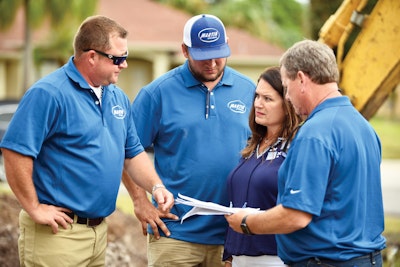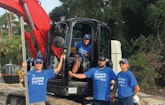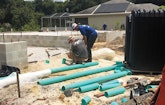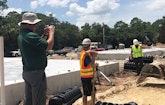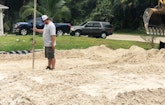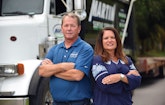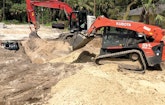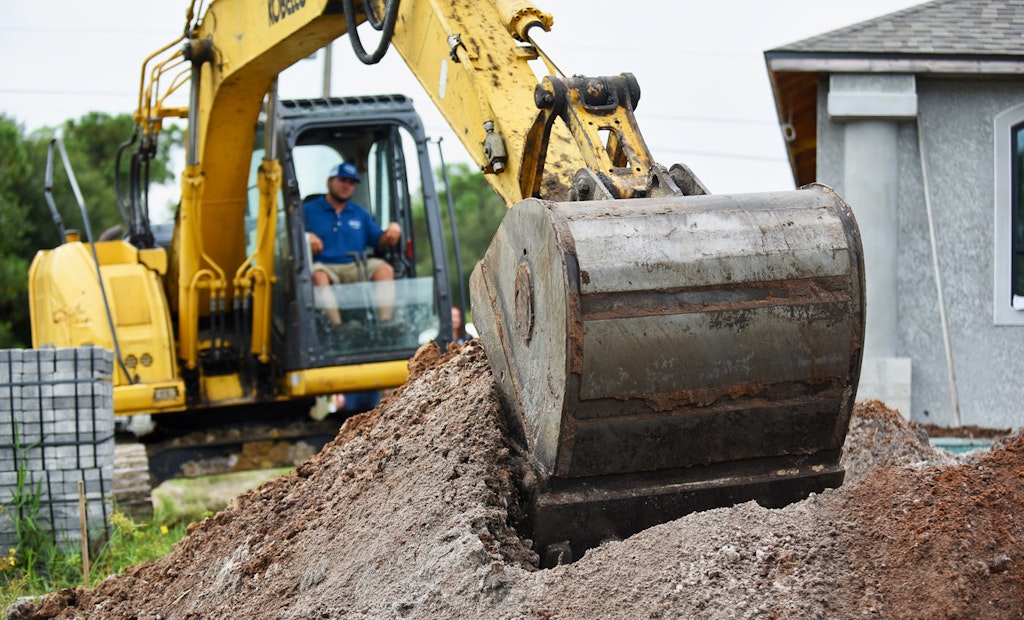
Installer Zachary Guffey uses a Kobelco excavator to move a spoils pile during an installation project.
A decade ago, Martin Septic Service was a large and diverse wastewater services provider. Through circumstances and choice, it’s now much smaller. But now it’s also just the right size for its market and workload. And it’s specialized enough so competition isn’t a large problem.
It’s taken Martin and Cindy Guffey many years to get the business to this point, and what they found is a sweet spot that enables them to be happy, do good work and understand what they don’t want to do. Before the 2008 recession, the company had 63 employees and was heavily involved in the homebuilding boom that was concentrated in part around North Port, Florida. Now Martin Septic is down to 15 people.
Gravity rules
The majority of systems Martin Septic installs in its five-county territory around North Port are standard septic systems, says Cindy Guffey, vice president and co-owner of the company. “This year, because of the building boom, we’ve installed quite a few more ATUs than in the last seven years.”
Yet overall, only 10% of the systems installed by the company use aerobic treatment. Technicians put in quite a few drip irrigation systems, but that is about as advanced as this part of Florida gets, she says. Concerns about algae blooms and water pollution will probably make nitrogen-reducing ATUs the technology of choice in southwestern Florida, she says, but she doesn’t see that happening for about 10 years.
“We do a lot of installations on waterfront property, even in the incorporated area of Port Charlotte,” she says. The street she and her husband live on in nearby Punta Gorda has municipal sewer, but the five streets beyond theirs are all served by onsite systems.
Because of a change in Florida’s code, installers know what kind of system a house needs depending on when it was built. Before 1983, Guffey says, homes could be built at ground level. Those lots typically require a lift station and a mound system because they otherwise cannot meet the minimum 12-inch separation between the bottom of a drainfield and seasonal high-water table.
After 1983, homes could be raised above the natural grade. You can see that driving around the area, Guffey says. An older house is at natural grade, but the house next to it is sitting on top of 4 or 5 feet of fill.
Waterfront properties are another challenge. Many were created during the construction of canals, Guffey says. Builders dumped their dredge spoils right beside the canals to create lots, so the soils are variable. (And this happens on lots away from the waterfront, too.)
“We run into some big boulders,” she says. Because the soil is typically poor, these installations require a lot of sand: about seven loads to build a bed and another two or three loads for cover.
Installations and service account for about 65% of the business, and pumping is about 35%. Technicians install about 11 systems per week, 65% of those for new homes and 35% for repairs or replacements.
ATU owners also must have maintenance contracts. Three full-time techs handle the 1,600 contracts Martin Septic has, and they also maintain lift stations, Guffey says.
Florida’s rains, and high-water table, provide their own challenge. In August 2018, one of the company’s technicians made the usual rounds with a load of water to fill tanks after the day’s installations.
“We had a 1,500-gallon concrete tank that floated because of the water table,” Guffey says. “You would naturally think, with the weight, there’s no way it would pop out of the ground. But it did.” In the process, it made a hole almost large enough for a shed to fall into.
Who needs an ad?
Like many established companies with good reputations, Martin Septic does little marketing.
“We have not advertised in the Yellow Pages for many years,” Guffey says. There is the company website, and there are referrals. These come mainly from local building contractors and Martin Septic’s repeat customers.
Another way to put the company’s name in front of the public is through sponsorships such as youth football and basketball. They also donate $3,000 for the Martin Septic Scholarship at the local high school. It’s money for college with no strings attached. Applicants write essays explaining why they want the money, and the company picks the recipients.
Equipment corner
Running this business takes a fair amount of equipment. At Martin Septic, the list includes:
- Three vacuum trucks: a 2006 Peterbilt from Keith Huber with a 4,000-gallon steel tank and Becker pump and a 2006 Peterbilt from Iron-Vac Truck Sales with a 2,450-gallon steel tank and Jurop/Chandler pump. The third rig is a 1983 military surplus truck retrofitted with a 2,500-gallon steel tank from Specialty B Sales and Masport pump. It was built out by Martin Septic and Southwest Mobile Mechanic; it’s kept at a local marina where there is a barge that hauls it to barrier islands along the coast.
- Three dump trucks: a 2006 Peterbilt, 2005 Peterbilt and 2002 Peterbilt. All have Warren dump bodies.
- Four excavators: a Kobelco 75, Kobelco 135, Kobelco 140 and Kobelco 160.
- A Kubota SVL95 skid-steer.
- A 721 Case loader.
- A Powerscreen screening machine: Old drainfield material is limed and run through the screener to separate plastic, wood and concrete debris from soil. Debris goes to a local landfill or recycling facility, and the soil is stockpiled for 30 days and then sold as fill.
- Two 2016 Mercedes Sprinter vans for the service techs. They’re very tall, Guffey says, and were bought for volume. It allows plenty of shelving and also allows techs to stand up inside so they can see everything and quickly locate what they need.
- A 2019 Chevy Silverado flatbed dual-wheel that can haul the skid-steer or the Kubota 75.
- A 2014 GMC 1500 four-door Denali service truck, plus a 2015 2500 GMC Denali and a 2016 2500 GMC Denali.
- A 1989 Mack Hydrobrute with a Del Zotto lifting rail to set tanks: Precast suppliers are 90 minutes to three hours away from North Port, Guffey says. Instead of ordering individual deliveries for each project, Martin Septic orders a semi load of tanks — five fit on a trailer — and stores them in the yard until they’re wanted.
- Three Globe trailers to move the excavators around.
Benefits to employees
This month, look for the Martin Septic crew at the Water & Wastewater Equipment, Treatment & Transport (WWETT) Show in Indianapolis. The Guffeys plan to bring five people to the show, a typical group for the trade shows they attend, she says. The reason for coming is simple: “It’s knowledge,” she says. “The key to our success has always been our employees.”
Technicians at a show learn about new equipment, new methods of working and new products that solve problems or increase productivity. Educating employees at the WWETT Show is only part of how the company creates success through the people it employs.
Also important is what else the company does for workers. It has a group health insurance plan and pays 100% of premiums. It pays year-end bonuses and has provided down payments for employees’ homes.
“We have always shared the financial success of our company with our employees in more than just a paycheck,” Guffey says. “That’s why our turnover is very low.”
In 2018 one person moved away, and the company hired two people. Last year the company hired a third service technician to handle the expanding workload.
People come in to fill out applications, but most hiring is done by word-of-mouth, Guffey says. For example, the company’s operations manager, Jeremy Felty, has been with Martin Septic for nine years. When he and his family moved back to the area from northeastern Florida, Guffey knew about it.
“His aunt I’ve known since I was 16 years old,” Guffey says. “I knew him since he was a young boy. I knew his work ethic as an adult. Jeremy is an enormous asset to Martin Septic, and we are extremely happy to have him on our team.”
Found their niche
Right-sizing their business took time. The Guffeys have found their niche, and they like it. They’re as happy with $4 million annual revenue as they were with $12 million, but there’s less stress, Guffey says. Having a smaller company is also a good choice for their stage of life.
“We’re tired,” she says. Her husband is partly retired. He started the company, she says: “He built it, he worked it, he ran it — now he’s ready to do what he wants to, when he wants to.” He remains active, but his rewards now come from helping neighbors and the community.
Guffey will follow her husband into retirement in a few years, but the next generation is in line to take over. Son Zachary Guffey is a lead installer for the company.
With the energy, skills and ideas of a new generation in the mix, Martin Septic is ready to adapt to whatever the future brings.
Helping people to help themselves
For 15 years, Martin Septic Service has been giving a hand to people willing to help themselves. The company does this through Habitat for Humanity, which builds homes for people without the means to buy them. Martin donates onsite systems and the labor to install them.
“Habitat, to me, it’s not just somebody giving you something. I feel it teaches people responsibility,” says Cindy Guffey, the company’s vice president and co-owner. “And the sweat equity — I love the sweat equity. It gives the owners a sense of what it takes to own a home, as well as some pride in their home.”
People who receive a Habitat house agree to pay a mortgage of some amount and must invest hundreds of hours of their own time in helping to build the house. That doesn’t include onsite work because of the special skills involved. Instead, Habitat families work on painting and framing their homes, Guffey says.
All the Habitat work around Charlotte and North Port, Florida, is new construction. In 2018 the Charlotte County Habitat chapter built 35 homes; in 2019 it was 36, Guffey says. Martin Septic donated five systems to the 2019 work.
The company has also donated land for Habitat homes. As the house-construction industry collapsed during the recession, Guffey says, contractors who owed money to Martin sometimes signed over lots as payment. She and her husband couldn’t see paying taxes on a bunch of vacant lots, so they donated them to Habitat.
In 2018, Martin’s work gained another advantage: Infiltrator Water Technologies became a partner and is providing tanks and chambers at no cost, Guffey says. “We provide the sand and labor, all the miscellaneous fittings — which is great because with Infiltrator contributing, we’ve been able to give more.”
